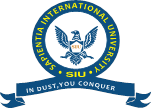SAPIENTIA INTERNATIONAL UNIVERSITY AND ODL
Open and Distance Learning (ODL) has taken the world by storm and becomes the mode of education delivery of the moment in USA and beyond.
ODL is aimed at bridging the time, geographical, economic, social, and educational and communication distance between student and institution, student and academics, student and courseware and student and peers. It focuses on removing barriers to access learning, flexibility of learning provision and student centeredness. The term distance refers to only half of the Open and Distance Learning equation. Open and Distance Learning encompasses not only teaching but learning; and highlights the teacher’s role rather than the system.
ODL is Learner-centered education in the sense that integrity and freedom of the individual is primary. Therefore, the teaching and learning process provides flexible sequences of study, negotiated objectives, content, learning methods, negotiated methods of assessment; and a choice of support mechanisms. The educational philosophy of Open Learning looks at giving learners choices about;
• medium or media, whether print, on-line, television or video, place of study
• whether at home, in the workplace or on campus,
• pace of study, whether closely paced or unstructured,
• support mechanisms, whether tutors on demand, audio conferences or computer-assisted learning;
• entry and exit points.
The term flexible learning accentuates the creation of environments for learning that have the following characteristics: convergence of Open and Distance Learning methods, media and classroom strategies; learner-centered philosophy; recognition of diversity in learning styles and learners’ needs; recognition of the importance of equity in curriculum and pedagogy; use of a variety of learning resources and media; and fostering of lifelong learning habits and skills in learners and staff.
The term, distributed learning, explores the learning itself rather than the type of technology used or the separation between teacher and learner; makes learning possible beyond classrooms; and when combined with classroom modes, becomes flexible learning.
The Characteristics of ODL are as follows;
• Separation of human teacher and learner in time or place, or in both time and place;
• The module becomes the ‘teacher’ who ‘interacts’ with the learner;
• Institutional accreditation; that is, learning is accredited or certified by some institution or agency. This type of learning is distinct from learning through your own effort without the official recognition of a learning institution;
• Use of mixed-media courseware, including print, radio and television broadcasts, video and audio cassettes, computer-based learning and telecommunications. Courseware tends to be pre-tested and validated before use;
• Two-way communication allows learners and tutors to interact as distinguished from the passive receipt of broadcast signals. Communication can be synchronous or asynchronous;
• Possibility of face-to-face meetings for tutorials, learner–learner interaction, library study and laboratory or practice sessions; and
• Use of industrialized processes; that is, in large-scale Open and Distance Learning operations, labour is divided and tasks are assigned to various staff who work together in course development teams.
The (SAPIU) is a unique institution of higher learning offering Open and Distance Learning (ODL) education and it is the only ODL University in the country. It started off in 2010 as the Centre for Distance Education under the SAPIU and has since grown into a fully fledged university. In order to sufficiently cater for students throughout USA and globally, SAPIU adopted a highly decentralised structure of opening Regional Centres in all the five places as well as the Virtual Region Centres for all international students.
SAPIU’s open and distance learning model offers a number of advantages to both learners and to providers of opportunities for learning. Problems such as distance and time, which are barriers to conventional learning, are overcome in open and distance learning. ODL overcomes problems of physical distance for learners in remote locations who are unable or unwilling to physically attend a campus; and learners and teachers geographically separated in that teachers in urban settings instruct learners in rural settings. SAPIU solves time or scheduling for student groups unwilling or unable to assemble together frequently, learners engaged in full-time or part-time work, both waged and volunteer; and family and community commitments.
Open and distance learning through SAPIU can expand the limited number of places available for campus-based institutions and overcome stringent entrance requirements. ODL can accommodate low enrolments over a long period of time and low enrolments. Open and distance learning can make the best use of the few teachers available when there is a lack of trained teaching personnel relative to demand or when teachers are geographically concentrated and teachers with certain expertise are in short supply. Open and distance learning can deal with differences in societal setups, and consequently widens women’s opportunities to learn, meets the needs of populations affected by violence, war or displacement; and makes learning possible even when group assemblies are prohibited.
